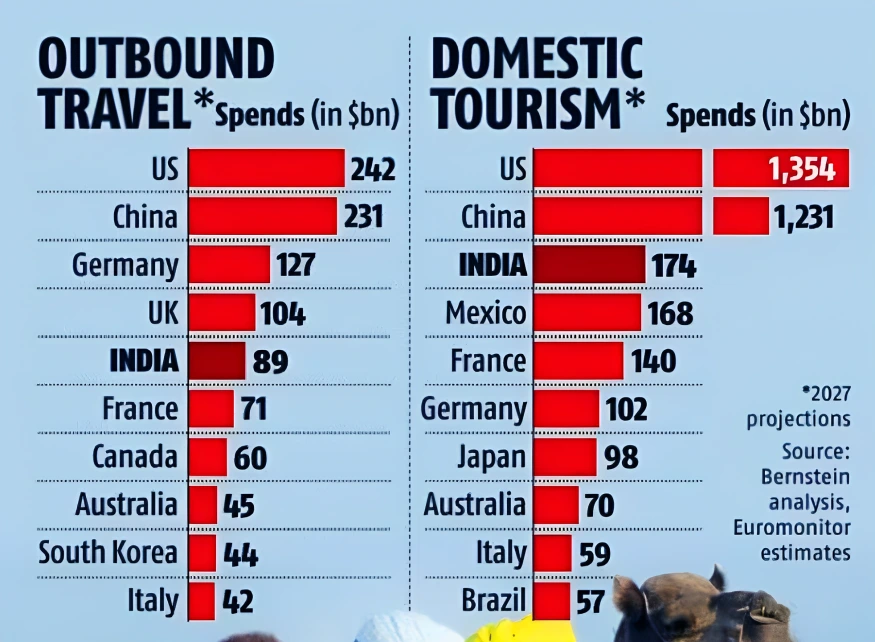Context: This article is based on an Editorial “India on course to become 5th-largest market for travel and tourism” which was published in the Business Standard. According to Bernstein’s report, the Indian travel market is expected to become the world’s fifth-largest by 2027, spending an estimated $89 billion on outbound travel.
| Relevancy for Prelims: Indian travel market, Outbound Tourism, World Tourism Organization (WTO), World Travel & Tourism Council (WTTC), G20 summit, and UNESCO World Heritage Sites In India.
Relevancy for Mains: Indian Tourism Industry; Current Status, Strengths, Weaknesses, and Way Forward. |
Indian Travel Market Statistics, 2022
- Tourist Inflows: India is projected to become the 3rd largest domestic market by 2027 with spending of $174 billion, up from the $127 billion spent in 2019 when it was in fifth place.
- Outbound Travel: Of the total travel share, outbound travel has gone up from 17% in 2019 to 32% in 2022.
- Domestic Tourism: Travel is concentrated in just 5 states- Tamil Nadu, Uttar Pradesh, Andhra Pradesh, Karnataka and Maharashtra.

Indian Travel Market: Current Status
- High Contribution to the Economy: As per the World Travel & Tourism Council (WTTC), the contribution is increasing and by the end of this year, it will be worth Rs 16.5 trillion.
- Tourist Arrivals in India: As per the Ministry of Tourism, Foreign Tourist Arrivals (FTAs) during the period January-March 2023 registered a growth of 222.4% higher than January-March, 2022.
Must Read: World Tourism Day 2023 – Theme, Significance, and More
Indian Tourism Industry: Strengths
- High Population with Increasing Wealth: According to Bernstein, the strength of India’s tourism industry lies in its high young population and the increasing wealth of 1/3rd of the population.
- Robust Demand: The travel market in India is projected to reach US$ 125 billion by FY27 with the international tourist arrivals expected to reach 30.5 million by 2028.
- Attractive Opportunities: India offers a variety of experiences, including 40 UNESCO World Heritage sites, archaeological remains, national parks and sanctuaries, the world’s highest mountain ranges, expansive beaches, the magnificent desert, and a rich cultural heritage.
- Policy Support: US$ 289.89 million allocated to the Ministry of Tourism as the sector holds huge opportunities for jobs and entrepreneurship for youth. An outlay of US$ 170.85 million has been allocated for the Swadesh Darshan Scheme.
- Government Initiatives: To promote tourism, various initiatives have been taken such as the “Incredible India” campaign. Also, policies and reforms have been implemented to ease visa processes, promote e-visa, and encourage foreign investment in the tourism sector.
- As per Assocham’s study, India’s travel and tourism industry has the potential to expand by 2.5% on the back of higher budgetary allocation and low-cost healthcare facilities.
Indian Tourism Industry: Weakness
- Infrastructure Challenges: Despite improvements, certain regions in India still face challenges related to infrastructure, including transportation, roads, and public facilities. The Travel and Tourism Competitiveness Index 2021 ranks India 54th out of 141 countries overall.
- Safety and Security Concerns: India faces many security risks due to which it was placed 41st for safety out of 42 in the World’s Safest Countries rankings in 2022.
- Lack of Connectivity to Remote Areas: Lack of adequate integration with other industries like hotel and accommodation, aviation, railway, healthcare, etc., impacts the tourism sector.
- Environmental Impact: Over-tourism in certain areas can lead to environmental degradation and strain on natural resources such as Uttarakhand has encountered an issue of overcrowding.
Way Forward
- Need for Tourism Friendly Infrastructure by improving integrated transportation networks, including roads, airports, and railways, to enhance accessibility to tourist destinations.
- Diversification of Tourism Offerings by exploring and developing niche tourism segments such as adventure tourism, wellness tourism, and cultural experiences to attract diverse travelers.
- Implementation of Supporting Government Policies that facilitate ease of travel, such as providing incentives for tourism-related businesses.
- Need of Collaboration with the private sector and local communities is required to create an enabling environment for tourism development.
- Development and implementation of effective marketing strategies to promote India as a premier tourist destination by using digital marketing platforms and social.
Conclusion:
The Indian travel market exhibits significant potential for growth, addressing infrastructure challenges, enhancing safety measures, and promoting diverse tourism offerings through collaborative efforts will be crucial for securing and sustaining its position as the world’s fifth-largest market by 2027.
![]() 9 Dec 2023
9 Dec 2023

